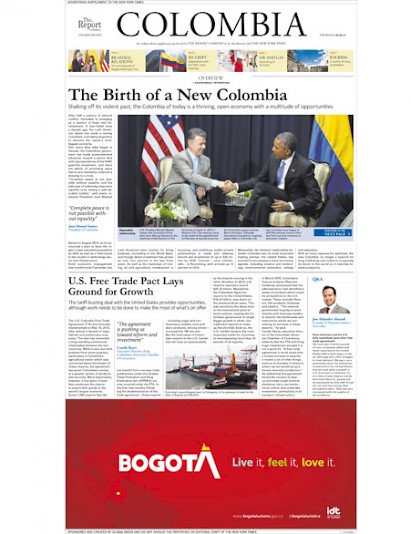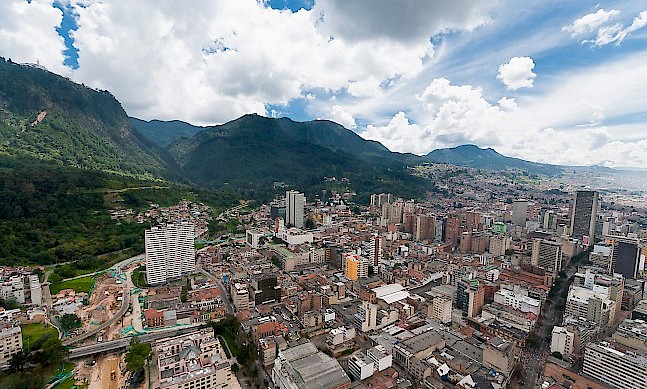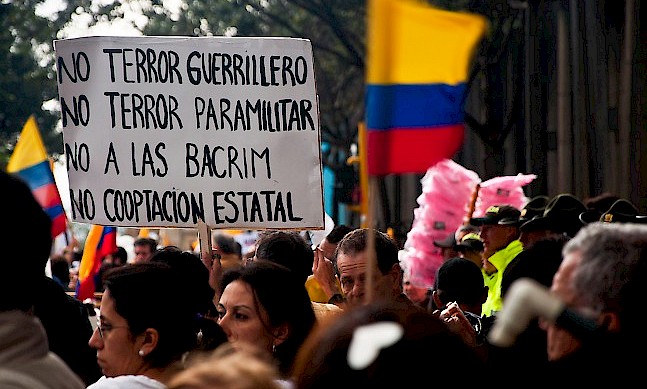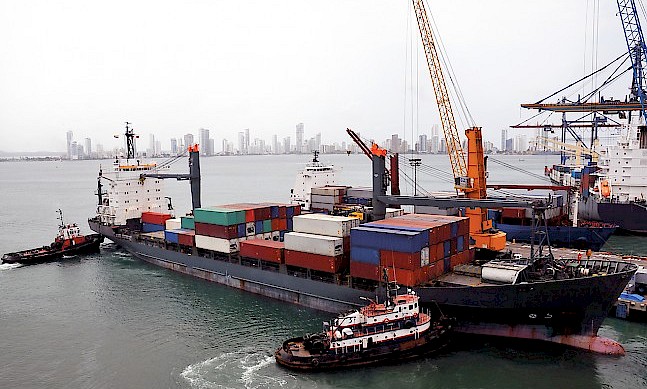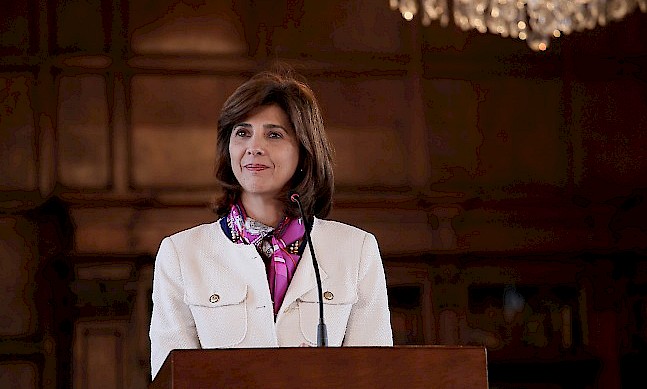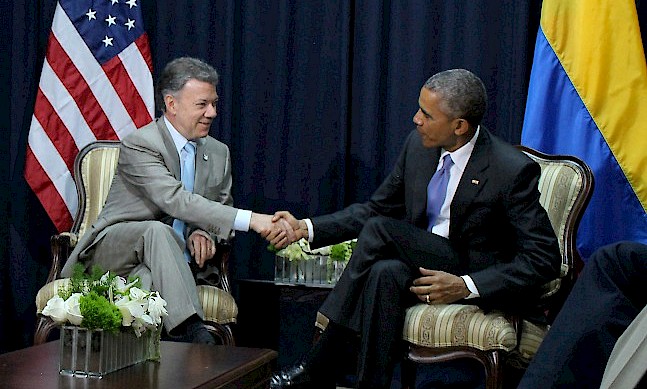One of Latin America’s largest banks, Bancolombia has expanded beyond the borders of its native Colombia to provide services in the greater region. Carlos Raul Yepes Jimenez, the bank’s CEO, spoke to The Report Company about the growing attractiveness of the Colombian banking sector to foreign players and the impact this is having on homegrown institutions.
The Report Company: What is the situation of the banking sector in Colombia right now?
Carlos Raul Yepes Jimenez: This is country of contrasts, where you can find very good things and very bad things. But Colombia is above all a society that is undergoing change, a society that was able to join the global arena by setting global goals for itself, not just goals at the Latin American level. The World Bank’s Doing Business Report shows that Colombia has improved significantly and positioned itself better in the global ranking. And the country’s macroeconomic behavior is excellent. Having an independent central bank has contributed very positively to the economy because of its management of the exchange rate policy, monetary policy, and control over inflation. Also, during the presidency of Alvaro Uribe, the nation’s goals were very clear: achieving democratic security and attracting foreign capital to the country, a process that is still underway.
TRC: What are the differences in economic policy between the previous Uribe administration and the current government?
CRYJ: I think that despite the political differences between Uribe and President Juan Manuel Santos, there is a continuity of the economic agenda, which acts like a guiding theme and a driving force behind our macroeconomic indicators. For a long time now we have been breaking unemployment records, keeping inflation under control and maintaining very good growth levels, in contrast with the general trend in Latin America and the world.
Our growth rate right now might easily be anywhere between 4.5 percent and five percent of GDP, which has translated into higher per-capita income. Ten years ago, per capita income in Colombia was $2,000 and now it is nearly $8,000. This has reactivated the economy and domestic demand. I feel that for the last five years or so we have been immersed in an era of possibilities, and there is a good chance that these possibilities are going to become realities soon. I believe there will continue to be a common agenda between the government and the business sector. That is the good news.
TRC: Where do you see challenges for the country?
CRYJ: I think that President Santos and his team have great challenges up ahead, with perhaps the greatest one – the one that has created the greatest unrest – being tax reform. There is a gap in the 2015 budget of nearly six billion dollars, and that gap needs to be covered. Proposals so far do not seem to have gotten very far, and there has been a lot of rejection to the proposed budget. But I feel, not just as head of Bancolombia but as an ordinary citizen, that we Colombians must be able to come up with the right proposal for a structural reform of the taxation system. This country has the right economic conditions for it, but there also needs to be the political will to back it up. Tax exemptions have to be reduced, the taxpayer base needs to be expanded, and we need to think about raising VAT. There is no opposition to paying taxes in this country; rather, there is an opposition to paying excessive taxes, which is what’s happening now.
TRC: What has Colombia’s financial system learned from the crises of 1998 and 2008?
CRYJ: I experienced both, the first one at the bank, the second one as a member of the board, and I really do think that the country has learned how to handle crisis situations and is better prepared. It has handled risk better, and its lenders are solid and in line with Basel III capital requirements. We at Bancolombia also have something we call responsible sales, which we developed after asking ourselves the question: how often are we ourselves, as a financial system, guilty of the bubbles? Are we selling products to people who don’t need them, or who can’t afford them, or who lack all the necessary information to make informed choices?
“I think that despite the political differences between Uribe and President Juan Manuel Santos, there is a continuity of the economic agenda, which acts like a guiding theme and a driving force behind our macroeconomic indicators.”Tweet This
TRC: How would you describe the country’s financial system today?
CRYJ: We have a solid financial system that is ready for growth, with healthy and balanced accounts. It has learned from crises of the past, and it is friendly.
TRC: What is the future of banking in Colombia?
CRYJ: The country has made significant progress in increasing bankarization, with the rate hovering around 68-70 percent, but there is still room for improvement. Meanwhile financial penetration also offers great opportunities. The financial system is changing; banks are probably going to do fewer things over the next five years than they are doing now, and that is why we have been adopting different approaches. In our particular case at Bancolombia, we are working towards a more human kind of banking, which means not just humanizing the financial system but also humanizing society. We don’t only have an economic role to play; we also have a role as social actors. Our ultimate message is that ethical integrity and top business performance must be compatible.
TRC: How do you put this philosophy into action?
CRYJ: Our motto is to respect all our clients, even those who are upset at us over something, because that means we have a problem fulfilling our promise to deliver value. For example, say you go to an ATM and it fails to give you the money you withdrew. It used to be that the issue had to be investigated, but I said no, let’s trust the client, give him the money immediately, because maybe $400 is not a lot of money to some people, but in countries like ours, for 99 percent of the population it is the difference between being able to survive the following week or not. A person should not have to struggle to make it through a week because the bank failed to meet its promise.
We were also the first bank to charge nothing for several services. I couldn’t understand why we were charging our own clients a fee for withdrawing cash from our ATMs. I want people to understand that we are not just a bank. We do more than just manage money, we also manage trust. We like to say that we are all important.
TRC: What role does technological innovation play in Bancolombia’s business?
CRYJ: We are not blind to what is going on in the world. Bancolombia handles 42 percent of all financial transactions in Colombia. That is a very significant figure. We handle 1.8 billion transactions a year, of which 92 percent are electronic transactions. Two years ago our mobile banking system was acknowledged as the best in the world. But of course it’s not banking that became mobile, it is life itself. Life is mobile, and that means that we need to be where and when and how the client needs us to be. We are present on any device. There have been close to two million downloads of our app for smartphones.
TRC: How far into Colombia’s regions does Bancolombia reach?
CRYJ: We have branches in all 32 Colombian departments. I doubt that there are very many businesses that can say that. One time I traveled to San Vicente del Caguan, in the guerrilla heartland. I like to go places where Bancolombia presidents have never been before, and my education at a Jesuit school really plays a role here. I like to go and talk to the people.
I went there, and the commander of the Omega Force, which is the joint military force there, told me: “When you come here, you bring peace. And we know that you’ll be putting your soul into it, like your company slogan says.” Another day a cattle rancher told me that he used to keep his cash inside a bag under the wood shavings in the bottom of a truck. That is how he used to carry his earnings from one location to another, and it took 10 hours, and he always prayed that it would not be discovered in a guerrilla attack. Now this man works differently; he has a Bancolombia bank branch where he gets help with everything he needs.
“We have a solid financial system that is ready for growth, with healthy and balanced accounts. It has learned from crises of the past, and it is friendly.”Tweet This
TRC: What is the bank’s international presence?
CRYJ: We are a universal bank with a regional presence and 10 million clients. The Bancolombia Group began its internationalization 40 years ago, when we opened a branch in Panama. We bought Banco Agricola in 2007 in El Salvador, and in the last three years we were able to acquire Banistmo for $2.3 billion and 40 percent of Banco Agromercantil in Guatemala.
We cannot say that we are a multinational; instead we are a universal regional bank that brings services to the region. To us, the “region” is Central America, the Caribbean, Colombia and Peru.
Another form of internationalization was being listed on the New York Stock Exchange (NYSE) 20 years ago. We’ve been very successful there. This means that our organization started out with superior standards many years ago, because we were not bound to Colombian legislation but to US legislation. So everything relating to corporate governance, conflicts of interest, auditing, compensation, the way our board works, our reports, everything, lives up to much higher standards.
TRC: What is Bancolombia’s capital markets strategy?
CRYJ: In the last three years, Bancolombia has been in the international capital markets raising nearly $8 billion. We went out into the capital markets to strengthen our portfolio and to meet Basel III standards, and we had a successful share issue in March for $1.3 billion. We’ve also just issued bonds worth $700 million, so that is close to two billion dollars this year alone.
TRC: Are you contemplating further growth?
CRYJ: Right now we have no projects for new acquisitions. In the last four years Bancolombia has doubled its assets, going from $35 billion to $70 billion, so now our goal is to consolidate this expansion. We have great challenges up ahead, especially in Panama. When you make acquisitions, you need more than just financial power, you also need management abilities. The third thing you need is the ability to project into the future. Our investment in infrastructure and technology this year alone, and I am talking just about Colombia, El Salvador and Panama, is close to $300 million, and right now our strategy is to consolidate this organic and inorganic growth that we have had over the last three years.
TRC: From an international perspective, foreign financial groups are coming to Colombia and Colombian businesses are going abroad. What kind of an impact has this had?
CRYJ: New players are welcome. Markets change, the competition changes, customers change, and we ourselves make everyone change. New players have arrived here at a significant time for the country because we have the right macroeconomic stability, but they bring new channels and new products with them. And we have to be careful not just about our financial competitors: the world is changing and other types of competitors are cropping up, such as technology platforms, start-ups who show up and say “I have an application that can do this or that,” which means that there is increasingly less mediation by banks.
These non-financial competitors pose a regulatory challenge in terms of how their revenues are going to be handled, what their obligations are, what clients they are going to attract, and what their capital levels are going to be. I’m not opposing any of this, on the contrary, but I feel there is a regulatory challenge up ahead to ensure there are no future problems for the financial system due to these new actors.
Bancolombia at a glance
42%
The proportion of Colombian financial transactions handled by Bancolombia
1.8bn
The number of transactions the bank handles per year
92%
The percentage of transactions handled electronically
1,070
The number of Bancolombia branches throughout Colombia in both urban and rural areas
30,158
The number of people directly employed by Bancolombia in Colombia


 Photo: Bancolombia
Photo: Bancolombia
